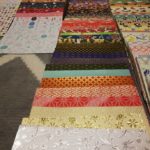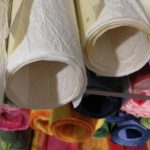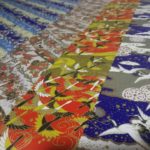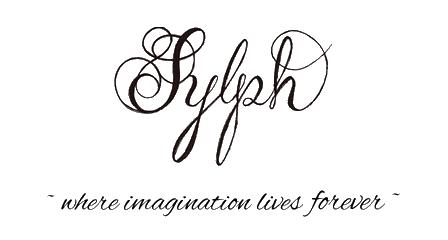* paper is a product produced in thin sheets from the pulp of wood or other fibrous materials *
collection
origami paper

usually comes in a square (75mm x 75mm, 15cm x 15cm), with various colours (plain, designed) on one or both sides, and usually weigh 70gsm to 90gsm
washi

traditional Japanese fibrous paper, either machine manufactured or traditionally handmade
made using fibers from the inner bark of the bark of the gampi tree, the mitsumata shrub (Edgeworthia chrysantha), or the paper mulberry (kōzo) bush
long fibres and intertwining of the fibres make it strong even when it is thin, which also allows good absorption of ink, making drawing/printing easier on it as it is able to hold very fine details
generally tougher than ordinary paper and is used in many traditional arts such as conservation and mending of books and paintings, origami, shodō, and ukiyo~e
Yuzen washi

inspired by kimono chiyogami patterns, they are usually brilliantly intense colours with gold metallic finish
handmade ones are extremely rare and expensive as each design is crafted by artists and silk screened by hand, one layer at a time, whereby each colour must be fully dried before the next colour is applied
surface
Hot Pressed/ Satinata/Liscia
the result from further pressing on a hot cylinder, bonding the fibres closer together to create a smoother and finer surface
Cold Pressed/Not/Fina
pressed for a second time without the blanket, flattening the surface that has been imprinted with the blanket, creating the perfect surface to hold pigment and carbon for drawing and watercolour painting as there is still tooth (surface texture)
Rough/Torchon/Grossa
most textured as the blankets are pressed on either side of the paper during manufacturing to create a heavily textured finish, which is perfect for abstract watercolours, landscape watercolours, and mixed media work where the dusty or dry pigments are attracted to the tooth
type
coated
book paper, glossy paper, inkjet paper, kraft paper, leather paper, wallpaper, waterproof paper, wax paper
usually coated with glossy, semi-gloss, or matte finishes, and does not have to be “glossy” to be considered coated, as an agent is added to the surface in order to improve brightness, smoothness, or other printing properties, after which the rollers will be used to help “polish” the paper, filling in the tiny pits and spaces between the fibres, producing a smooth, flat surface
coating produces a bright and shiny outlook and prevents ink from bleeding besides making the paper more resistant to dirt, moisture and wear, increasing its durability
uncoated
bank paper, banana paper, bond paper, book paper, cartridge paper, construction/sugar paper, cotton paper, fish paper, inkjet paper, laid paper, leather paper, matte paper, mummy paper, sand paper, wallpaper, washi, wove paper, xuan paper
generally rougher and tends to be more porous, which makes it very absorbent making images printed softer and less crisp
the best archival grade paper is made from 100% cotton paper produces a strong, acid~free material which lasts a long time, and is the most resistant to discolouration and deterioration, making it the perfect choice for an archival grade paper
however, the interweaving fibres which gives its inherent strength is improved by the use of ‘size’ making it prone to disintegrate when it is to wet
wood free paper is made by treating the wood pulp, removing the element of fibre which yellows and through its acidity causes the paper to deteriorate, giving an economical acid~free paper
paper may turn brittle and yellow over time due to the lignin content (a part of the plant that helps to bind cells making them woody and stronger) from the fibres, thus if you are looking for longevity, choose an acid~free or pH neutral paper
Tyvek® is a 100% synthetic material made from high-density spunbound polyethylene fibers, having properties such as being breathable, durable, and lightweight, yet resistant to abrasion, aging, bacterial penetration, and water
weight
gsm or lbs
(gsm) 75, 80, 90, 100, 105, 120, 130, 145, 150, 165, 170, 175, 200, 215, 255, 270, 350
the various weights, are expressed in lbs (pounds) or gsm (grammes per square metre), thus as a rule of thumb, the heavier the paper, the thicker the paper
drawing papers are typically 130 gsm and fine art papers are made in the range of 120 gsm to 850 gsm, but oriental papers tend to be lighter

